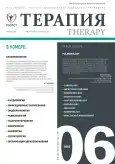Expert consensus on the issues of urinary incontinence in elderly and senile patients
- Autores: Drapkina O.M.1, Adamyan L.V.1, Shamalov N.A.1, Pushkar D.Y.1, Tkacheva O.N.1
-
Afiliações:
- the Ministry of Healthcare of Russia
- Edição: Volume 9, Nº 6 (2023)
- Páginas: 128-130
- Seção: HELPING PRACTICING PHYSICIAN
- URL: https://journals.rcsi.science/2412-4036/article/view/258883
- DOI: https://doi.org/10.18565/therapy.2023.6.128–130
- ID: 258883
Citar
Palavras-chave
Texto integral
##article.viewOnOriginalSite##Sobre autores
O. Drapkina
the Ministry of Healthcare of Russia
Autor responsável pela correspondência
Email: abramova@bionika-media.ru
md, professor, academician of RAS, chief external specialist in internal medicine and general practice
Rússia, MoscowL. Adamyan
the Ministry of Healthcare of Russia
Email: abramova@bionika-media.ru
md, professor, academician of RAS, chief external specialist in gynecology
Rússia, MoscowN. Shamalov
the Ministry of Healthcare of Russia
Email: abramova@bionika-media.ru
md, professor, chief external specialist in neurology
Rússia, MoscowD. Pushkar
the Ministry of Healthcare of Russia
Email: abramova@bionika-media.ru
md, professor, academician of RAS, chief external specialist in urology
Rússia, MoscowO. Tkacheva
the Ministry of Healthcare of Russia
Email: abramova@bionika-media.ru
md, professor, corresponding member of RAS, chief external specialist in geriatrics
Rússia, MoscowBibliografia
- Sexton C.C., Coyne K.S., Kopp Z.S. et al. The overlap of storage, voiding and postmicturition symptoms and implications for treatment seeking in the USA, UK and Sweden: EpiLUTS. BJU Int. 2009; 103(Suppl 3): 12–23. https://dx.doi.org/10.1111/j.1464-410X.2009.08369.x.
- Liberman J.N., Hunt T.L., Stewart W.F. et al. Health-related quality of life among adults with symptoms of overactive bladder: Results from a U.S. community-based survey. Urology. 2001; 57(6): 1044–50. https://dx.doi.org/10.1016/s0090-4295(01)00986-4.
- Irwin D.E., Kopp Z.S., Agatep B. et al. Worldwide prevalence estimates of lower urinary tract symptoms, overactive bladder, urinary incontinence and bladder outlet obstruction. BJU Int. 2011; 108(7): 1132–38. https://dx.doi.org/10.1111/j.1464-410X.2010.09993.x.
- Воробьева Н.М., Ткачева О.Н., Котовская Ю.В. с соавт. Российское эпидемиологическое исследование ЭВКАЛИПТ: протокол и базовые характеристики участников. Российский журнал гериатрической медицины. 2021; (1): 35–43. [Vorobyeva N.M., Tkacheva O.N., Kotovskaya Yu.V. et al. Russian epidemiological study EVKALIPT: Protocol and basic characteristics of participants. Rossiyskiy zhurnal geriatricheskoy meditsiny = Russian Journal of Geriatric Medicine. 2021; (1): 35–43 (In Russ.)]. https://dx.doi.org/10.37586/2686-8636-1-2021-35-43. EDN: OSMVEM.
- Tang D.H., Colayco D.C., Khalaf K.M. et al. Impact of urinary incontinence on healthcare resource utilization, health-related quality of life and productivity in patients with overactive bladder. BJU Int. 2014; 113(3): 484–91. https://dx.doi.org/10.1111/bju.12505.
- Abrams P., Kelleher C.J., Kerr L.A., Rogers R.G. Overactive bladder significantly affects quality of life. Am J Manag Care. 2000; 6(11 Suppl): S580–90.
- Engstrom G., Henningsohn L., Walker-Engstrom M.L., Leppert J. Impact on quality of life of different lower urinary tract symptoms in men easured by means of the SF 36 questionnaire. Scand J Urol Nephrol. 2006; 40(6): 485–94. https://dx.doi.org/10.1080/00365590600830862.
- McGhan W.F. Cost effectiveness and quality of life considerations in the treatment of patients with overactive bladder. Am J Manag Care. 2001; 7(2 Suppl.): S62–75.
Arquivos suplementares








